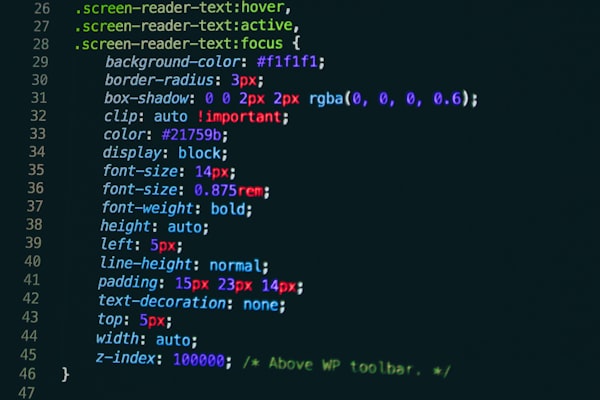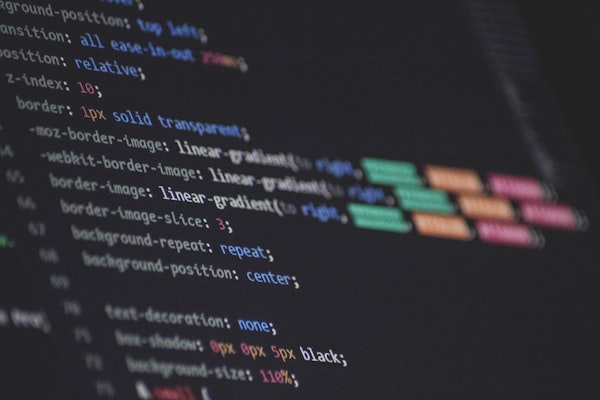1. Introduction to CSS Variables: What and Why?
Ah, the digital realm of cascading style sheets! Where pixels and percentages dance, and elements play hide-and-seek. Enter our hero: the CSS Variable (also known as Custom Properties for the aristocrats).
Now, for those who've been living under a proverbial digital rock (or perhaps just offline on a Zen retreat), CSS Variables allow us to store specific values for reuse throughout our style sheet. It’s like giving a name to your favorite shade of midnight blue so you don’t have to remember that specific RGB value every darn time. Efficient, right?
So, why the hullabaloo about CSS Variables? Well, beyond them sounding incredibly techy and giving you bragging rights at web designer parties, they make the job of coding dynamic and themeable designs a breezy walk in the park. Think of it as having a Swiss Army knife in your CSS toolkit. With CSS Variables, you’re not just coding; you're orchestrating a symphony of responsive, maintainable, and, dare we say, delightful designs. Let the symphony commence!
2. Setting the Stage: Basic Syntax of CSS Variables
Cue the spotlight, dear readers, for it's time to unveil the star of our show: the syntax of CSS Variables! If CSS were a Broadway play, variables would be its leading characters, bedazzling the audience with their flexibility.
Start by declaring a CSS variable with the artful use of double dashes. This isn’t Morse code or an overly dramatic pause in a Shakespearean play; it’s just the way we roll in CSS-ville. For instance:
:root {
--main-color: #ff4500;
}
Bam! There you have it. The --main-color variable is now storing the oh-so-sultry shade of #ff4500, ready to paint your web canvas wherever you wish.
To use this variable elsewhere in your stylesheet, summon it with the var() function. It’s like calling a genie out of a bottle, but instead of three wishes, you get infinite design possibilities:
body {
background-color: var(--main-color);
}
Tada! Our page’s backdrop now radiates in that vibrant hue. The beauty of CSS Variables lies not just in their initial declaration but in their dynamism. Change --main-color once, and it ripples through wherever it's invoked, like whispers in the grand theatre of web design.
This syntax – so seemingly simple, yet so profound – is your passport to a realm of fluid, dynamic, and oh-so-smart designs. So next time you find yourself lost in a sea of hex codes or repetitive styles, just remember: with CSS Variables, you've got the magic wand to craft coherence with a flair for drama!
3. Advantages of Using CSS Variables in Web Design
Roll out the red carpet, folks, because we're diving into the star-studded benefits of using CSS Variables. If CSS Variables were up for an award in the ever-evolving world of web design, they'd be swiping Oscars left and right! But why, you ask? Let's deep dive:
- Dynamic Theming Magic: Ever wanted to swap out colors, fonts, or spacings on a whim? CSS Variables make your designs as adaptable as a chameleon at a color-changing contest. User preferences, dark modes, or seasonal themes? Achieved in a snap with our variable friends!
- Maintainability Maven: Imagine a world where a single line change cascades gracefully across your entire site. It’s not a dreamy scene from a coder's fairy tale; it's the maintainable reality with CSS Variables. One update, and your design elements sing in harmony, no matter how vast your stylesheet empire!
- Consistency is Key: Maintaining visual consistency across a website can be as tricky as balancing a spoon on your nose. But with CSS Variables? It’s like having a trusty measuring tape ensuring every design element aligns to perfection.
- Performance and Efficiency: Sure, pre-processors have their place in the limelight, but native CSS Variables deliver dynamism straight from the browser's playbook. Fewer HTTP requests and seamless integration? That's like getting a VIP pass to the front row of the design show.
- Future-Proof Finery: In the grand theater of web evolution, CSS Variables are not just a passing fad. They are here for the long haul, ensuring your designs stay relevant, flexible, and in vogue with the times.
- Developer Joy and Collaboration: Let's face it, when developers are happier, the digital universe is a brighter place. With clearer code annotations and less repetition, CSS Variables foster collaboration and reduce those pesky "What does this magic number mean?" queries.
So, when you opt for CSS Variables, you're not just choosing a feature. You're embracing a design revolution, elevating your websites to artful masterpieces that are as practical as they are beautiful. And isn't that what web design's all about? Standing ovation, anyone?
4. Real-World Examples: Dynamic Designs with CSS Variables
Grab your digital magnifying glasses and your most stylish detective hats, because we're embarking on a virtual tour of the modern web’s art galleries. What are we hunting? The elegant, the chic, and the downright ingenious applications of CSS Variables in the wild.
- The Day-to-Night Website: Picture a site that transitions from a sunny, vibrant palette during the day to a moody, dark mode as the sun sets. All achieved by dynamically tweaking a handful of CSS Variables based on user time zones. It's not sorcery; it's just super-smart design!
- Personalized User Themes: User logs into a dashboard and, lo and behold, the interface sings in their favorite shades of teal and coral. By leveraging user preferences stored in databases, CSS Variables get to work, rendering a tailor-made theme. Customization has never looked so chic!
- Responsive Typography: On desktop, a bold and grandiloquent font size, while on mobile, a more restrained and dainty one. CSS Variables, when combined with media queries, ensure that typography scales, morphs, and adjusts, giving every device its typographic moment to shine.
- Interactive Art: Websites that react to cursor movements or ambient light, changing colors or sizes in response. It's like the Northern Lights on your screen, all thanks to the dynamic duo of JavaScript and our beloved CSS Variables.
- Seasonal Overhauls: Winter brings snowflakes and cool blues, while summer sizzles with suns and fiery reds. E-commerce sites and blogs alike harness the prowess of CSS Variables for seasonal makeovers, ensuring they always stay in vogue, come rain or shine.
- Animations with Pizzazz: Hover effects that shift color gradients, or buttons that pulsate with rhythm. All these visual candies, sprinkled and fine-tuned with the magic of CSS Variables, take web interactivity from bland to grand!
So, the next time you meander through the digital boulevards and marvel at the spectacular design displays, remember: behind many of those dynamic marvels, CSS Variables are the unsung heroes, crafting experiences that captivate, inspire, and, most importantly, resonate with the real world. Happy exploring!
5. Browser Compatibility: Ensuring Your Designs Work Everywhere
Ah, the age-old conundrum: crafting a digital masterpiece, only to realize it looks like abstract art on a different browser. The virtual equivalent of spilling coffee on a freshly painted canvas! But fear not, for when wielding the mighty sword of CSS Variables, one must simply be aware of the lay of the Browser Land to ensure a consistent spectacle for all.
- A Glimpse into History: While modern browsers have embraced CSS Variables like a long-lost friend, some older browsers, ahem Internet Explorer, look at them with a perplexed squint. Knowing your audience and their browser tendencies is key. If you're catering to a crowd still loyal to vintage browsers, tread carefully!
- Modern Browsers, Modern Designs: The likes of Chrome, Firefox, Safari, and Edge? They're the cool kids in the browser block, giving a nod of approval to CSS Variables. So, for the most part, your dynamic designs will shimmer and shine as intended here.
- Polyfills to the Rescue: For those heart-wrenching times when a browser throws a tantrum, polyfills are your superheroes. They bridge the gap, allowing older browsers to understand and render CSS Variables. It’s like having a translator for an opera sung in a foreign tongue.
- Testing, Testing, 1, 2, 3: Tools like BrowserStack or CanIUse are your backstage crew, ensuring the show goes on smoothly. Regular compatibility checks and updates will keep those unexpected design glitches at bay.
- Graceful Degradation: Sometimes, it's okay to let go. If a design feature isn't crucial, allowing it to degrade gracefully on unsupported browsers can be a strategic choice. Think of it as an unplugged version of a rock song—still delightful, just a bit different.
- Educate and Illuminate: Occasionally, a gentle nudge urging users to update their browsers can work wonders. A friendly reminder that newer versions offer more security, speed, and a better visual feast can be persuasive.
To sum it up, while the world of CSS Variables offers a Pandora's box of design wonders, ensuring they shine consistently across the browser spectrum is an art and science combo. But with a mix of strategy, testing, and a sprinkle of patience, you can ensure your web canvases are masterpieces, no matter where they're viewed. Onward, brave designer, to cross-browser harmony!
6. Best Practices for Organizing and Naming CSS Variables
In the bustling metropolis of web design, CSS Variables are like the street signs and landmarks, guiding us through the labyrinth of styles. But just as "3rd St." is clearer than "That one street next to Bob's Pizzeria," our variable-naming conventions need a sprinkle of wisdom and a dash of clarity. Let’s embark on this journey of organization and nomenclature enlightenment!
- Start Global, Think Local: Utilize the
:rootselector for globally applicable variables, creating a central repository of your design tokens. It's like having the main controls of a spaceship at your fingertips. - Descriptive Over Prescriptive:
--main-bg-colortells a richer tale than--color1. Aim for names that describe the variable's purpose or appearance rather than its sequence or temporary value. - Consistency is the Name of the Game: If you start with
--font-size-large, stick with that format. Don't suddenly shift to--LargeFontSize. It’s akin to swapping from driving on the right to the left midway through the journey. Chaos, my friend! - Use a System, Not a Whim: Adopt a naming strategy, be it BEM, SMACSS, or your own secret sauce. It's like choosing whether to arrange your bookshelf alphabetically, by genre, or by color—just pick a method and stick with it.
- Group and Comment: Cluster related variables together and sprinkle in some comments. It not only aids fellow developers but also your future self. Think of it as leaving breadcrumbs for Hansel and Gretel, ensuring no one gets lost in the woods of your stylesheet.
- Avoid Over-Specificity:
--homepage-hero-section-font-sizemight seem like a good idea initially, but what happens when this variable finds use elsewhere? Keep names flexible, like--hero-font-size, to cater to potential design evolutions. - Embrace Modularity: If you're working on a large project or a design system, consider splitting your variables into multiple files or sections. Typography, colors, spacings—they can all have their own cozy corners.
In essence, naming and organizing CSS Variables isn't just a task; it's an art form. The clearer your conventions, the smoother the design process becomes. After all, in the world of dynamic designs, CSS Variables are the unsung heroes, and their names? Their rallying cries! So wield them with wisdom, and watch your designs not only shine but also communicate with eloquence and clarity.
7. CSS Variables vs. SASS/SCSS Variables: What's the Difference?
In the grand coliseum of web styling, two gladiators often find themselves locking horns: CSS Variables and SASS/SCSS Variables. While both are champions in their own right, understanding their unique strengths, styles, and swagger can be pivotal for web maestros like you. So, let's pull back the curtains and unravel the tales of these two titans!
- Origins and Allegiances: CSS Variables (or Custom Properties) are native to CSS, born from the modern browser's codebase. On the other hand, SASS/SCSS Variables hail from the SASS preprocessor kingdom, requiring a compilation step to transform into standard CSS.
- Dynamism vs. Static Nature: CSS Variables truly shine when it comes to runtime changes. Want to switch themes on user interaction? CSS Variables leap into action without breaking a sweat. SASS/SCSS Variables, however, are set in stone once compiled, reminiscent of ancient runes that don't change with the wind.
- Scope and Accessibility: In the CSS Variable realm, you can set global variables or limit them to specific components. They play well with JavaScript, making for delightful interactive designs. SASS/SCSS Variables? They have their own scoping rules, often bound by the curly braces that encase them.
- Fallback Flexibility: With CSS Variables, you can provide fallback values right in the
var()function, ensuring that if a variable isn't set, your design doesn't crumble like a cookie in milk. SASS/SCSS Variables require a different strategy, often leveraging default values. - The Toolchain Tango: To dance with SASS/SCSS Variables, you'll need a compilation step, often involving tools like Webpack or Gulp. CSS Variables? They waltz straight into the browser, no invites needed!
- The Syntax Showdown: While CSS Variables embrace the double dash (
--) convention, SASS/SCSS Variables step into the spotlight with a dollar sign ($) leading their parade. It's like the difference between a bowtie and a necktie—both stylish, just distinct.
In summation, while both CSS Variables and SASS/SCSS Variables bring panache and power to the styling soiree, they cater to different design philosophies and workflows. The choice isn't about which is universally superior, but rather, which aligns better with your project's rhythm, needs, and narrative. So, designers, arm yourselves with knowledge, pick your champion, and let the styling games begin!
8. Responsive Designs: Adjusting Layouts Dynamically with CSS Variables
In the kaleidoscopic world of web design, there's one performance that consistently sells out arenas: The Grand Responsive Show. And the rockstar, belting out those high notes? CSS Variables, of course! Let’s dive into how these dynamic divas ensure your website's layout is as fluid as a ballet dancer adjusting to any stage—be it a gargantuan theater or a cozy coffee shop nook.
- The Fluid Font Symphony: Ever wished your typography could gracefully scale, like a singer adjusting octaves? With CSS Variables, you can seamlessly shift font sizes based on viewport widths. No more squinting on mobiles or feeling adrift in a sea of text on desktops!
- Margin and Padding Magic: No more hard-coded spacings that make your designs feel either claustrophobic or eerily empty. Set variables like
--main-marginand watch as your content breathes and stretches with elegance across devices. - Dynamic Grid Gurus: Columns, gaps, and rows, oh my! CSS Variables allow for grids that adapt—shifting from a multi-column extravaganza on a desktop to a streamlined single column on mobile. It's like watching a chameleon seamlessly blend into diverse environments.
- Color Schemes that Care: Think of a design that subtly adjusts shades based on ambient lighting or time of day. Perhaps a softer palette for nighttime browsing? CSS Variables, in tandem with media queries, make such design sensitivity not just a dream, but a dynamic reality.
- Interactive Elements Elevate: Buttons that resize, icons that adjust, and interactive elements that know just how to behave on touch vs. hover. CSS Variables make these nuances second nature, enhancing user experience across devices.
- Background and Border Ballet: From intricate patterns that scale gracefully to borders that know when to be bold and when to fade, CSS Variables serve as the choreographers orchestrating this visual ballet.
- Performance and Precision: Leveraging CSS Variables doesn’t just make your designs adaptive, but also efficient. Instead of overloading with device-specific stylesheets, a few variable tweaks do the trick, ensuring lighter loads and swifter sites.
In essence, responsive design with CSS Variables is not just about fitting content into different screen sizes. It's a holistic approach, a symphony where each element knows its cue, ensuring the audience—your users—get a consistently mesmerizing experience. So, wave the conductor's baton, let CSS Variables take the lead, and watch as your designs waltz, tango, and jive across the vast dance floor of devices. Encore! Encore!
9. Overcoming Challenges: Common Issues and Their Fixes
Every masterful symphony has its crescendos and its occasional off-notes. Similarly, while CSS Variables can paint a dynamic design masterpiece, they sometimes throw us a curveball or two. But fret not, for every challenge is merely an encore in disguise, awaiting a standing ovation. Let's demystify these common conundrums and their savvy solutions.
- The Undefined Enigma: Ever set a CSS Variable and then, much to your chagrin, found it MIA in action? This often occurs when the variable isn't defined in the current or any ancestor scope. The fix? Ensure you've set it globally in
:rootor within the relevant selector's reach. - The Cascade Cascade: Remember, CSS Variables adhere to the cascade. If you set a variable inside a specific selector, it might override a global value. Taming this wild beast involves understanding specificity and ensuring intentional overrides.
- Dynamic Drags: Intending for real-time design dynamism but facing lag or jitters? Be wary of overburdening JavaScript with excessive CSS Variable updates. Fine-tune performance by minimizing reflows and repaints.
- Fallback Fiascos: Occasionally, despite our best efforts, fallback values don't kick in. The trick? Ensure you're using the correct syntax within the
var()function, like so:var(--my-variable, fallbackValue). - The Inheritance Intrigue: Unlike other properties, CSS Variables are inheritable by default. This means if you set one on an element, its descendants inherit it—unless you dictate otherwise. Mastering this nuance ensures designs that are predictably dynamic.
- Polyfill Pitfalls: Relying on polyfills for older browser support? Ensure they're up-to-date and integrated correctly. Sometimes, the smallest missteps—like loading orders—can lead to grand hiccups.
- Mysterious Media Queries: Planning on changing CSS Variables within media queries? Make sure the queries are correctly structured and not conflicting with one another. Harmony in responsiveness ensures a ballet, not a brawl.
In the vast seas of dynamic design, challenges with CSS Variables are but mere ripples. And each ripple? An opportunity to steer the ship with newfound knowledge and finesse. So, don your captain's hat, navigate with confidence, and let your designs sail smoothly through even the stormiest of web waters. To challenges overcome and to masterpieces yet to be crafted!
10. Beyond the Basics: Advanced Techniques with CSS Variables
As you delve deeper into the rich tapestry of web design, CSS Variables emerge not just as mere tools, but as wands waving magical nuances. Like a seasoned chef moving beyond salt and pepper, it’s time to explore exotic spices and gourmet techniques. Prepare for a feast as we embark on this advanced culinary journey of CSS Variables.
- Theming Theatrics: Imagine the power to switch between light and dark modes, or even entirely unique themes, with just a few variable tweaks. By creating comprehensive theme variables, users can feel empowered to set their visual ambiance.
- Mathematical Marvels: Combine CSS Variables with
calc(), and the design possibilities multiply. Dynamically adjust dimensions, spacings, and more, creating layouts that respond like living entities to user preferences and interactions. - The Power of Properties: Consider binding CSS Variables to specific HTML attributes, harnessing the prowess of data attributes. For instance, a
data-colorattribute can directly influence a component's color, making components that are as customizable as LEGO bricks. - Animation Antics: CSS Variables in the world of animations? Absolutely! By tying variables to animation properties, achieve subtle transitions or dramatic reveals, all governed by user actions or contexts.
- Interactivity Illuminated: Let JavaScript converse with CSS Variables. Whether it’s to adjust styles based on scroll positions, mouse movements, or any real-time data, this symbiotic relationship between JS and CSS Variables can craft captivating experiences.
- Logical Labyrinths: Embrace the future with CSS Conditional Rules. Use
@supportsto check if a browser can digest CSS Variables, ensuring that you serve the optimal dish, be it a gourmet feast for modern browsers or a comforting classic for the older ones. - Hierarchical Harmony: Dive into the depth and leverage the
var()function within another. Nested variables provide granular control, allowing for intricate design systems with foundational variables affecting more specific ones. - Global vs. Component Specificity: While the
:rootselector is your global pantry of variables, don’t shy away from declaring component-specific ones. This ensures components retain their essence even when uprooted and placed in different design landscapes. - Dynamic Gradients: Why limit dynamic shifts to solid colors? By interchanging gradient values with CSS Variables, achieve backgrounds and overlays that morph based on user interactions, creating a visual dance of hues.
Venturing into advanced terrains with CSS Variables is akin to a maestro mastering intricate symphonies. With every new technique, your design repertoire expands, ready to dazzle and deliver. Remember, it's not just about knowing the notes but playing them with flair, finesse, and an intrinsic understanding of the audience. To design orchestrations that resonate, echo, and leave an indelible mark!








